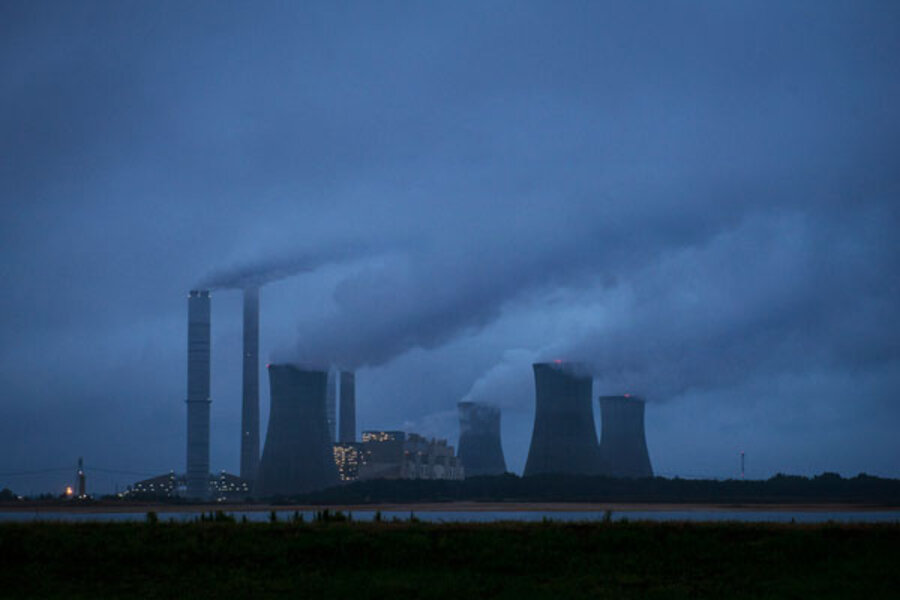Obama climate change plan 101: What's in new EPA rules?
Loading...
| Washington
The Obama administration on Monday unveiled a sweeping plan to curb US power plant emissions linked to climate change. The proposed Environmental Protection Agency regulation aims to reduce the carbon dioxide created in the production of US electricity by 30 percent from 2005 levels over the next 15 years.
Under the plan, each state would have its own goal within the overall national pollution reduction effort. That’s an attempt to be politically and practically flexible in implementation.
“The glue that holds this plan together – and the key to making it work – is that each state’s goal is tailored to its own circumstances, and states have the flexibility to reach their goal in whatever works best for them,” said EPA Administrator Gina McCarthy on Monday as she announced the plan.
It’s important to note that this is not a signed-and-sealed deal. It’s the first public step in a regulatory process that provides lots of time and opportunity for critics to make themselves heard and attempt to influence the proposal’s outcome.
Given that, we’ll try to explain some of its basics in simple terms so as to provide background for forthcoming follow-up stories.
Is this a big deal? Yes. To the Obama administration, this is a major move by the United States to show it is attempting to grapple with the preeminent environmental problem of the day. Administration officials think that’s important because if the US doesn’t try and deal with this, other big polluters such as China and India won’t either.
In political terms, it may the biggest thing the White House tries to accomplish in domestic policy in Obama’s remaining months in office. Given continued GOP control of the House, and possible control of the Senate following upcoming midterm elections, Obama’s legislative initiatives are pretty much over. But the carbon emissions plan is a proposed regulation – something a president can do via unilateral executive action, within certain legal limits.
How would it work? First, the EPA would set targets for each state for carbon emissions reductions. Then state governments would come up with their own plans for hitting these targets. The proposed regulation in essence gives them four different approaches they could try. They could renovate existing coal-fired plants with newer, more clean-burning technology; they could switch coal plants to natural gas, which produces much less carbon; they could try to persuade residents to be more efficient in their use of electricity; or they could band together with other states in a cap-and-trade network for emission reductions.
In a cap-and-trade network, companies would buy and sell permits allowing them to produce a certain amount of carbon emissions. Clean producers would be the sellers, while dirtier producers would be the buyers.
If you want more detail you can read the whole proposed EPA regulation here. Warning: it’s over 600 pages.
Is the target ambitious? Yes and no. It would represent an absolute reduction in US carbon emissions of nearly one-third, not simply a slowing of the rate of emissions growth. But the cut would be measured not from current levels but from those that existed in 2005. Emissions from fossil-fuel power plants have already fallen by 13 percent since then. That’s because the recession lowered demand for electricity, and many utilities are already switching plants to cleaner natural gas as shale fracturing (aka “fracking”) increases gas supplies and lower prices.
So the US is already almost halfway to the target. Some environmental groups had hoped the administration would set more ambitious pollution reduction goals.
What happens now? Lobbying, and lots of it. The EPA today published its proposed rule for the carbon emissions reductions in the Federal Register. That’s the official start to a year of comments by affected parties until the final rule gets issued in 2015. Industry groups, many Republicans, and some coal-state Democrats don’t like this proposal and they are sure to weigh in with complaints about its costs and increased regulatory burden.
They will fight hard. The EPA proposals is “a dagger in the heart of the American middle class,” said Senate minority leader Mitch McConnell (R) of Kentucky, a coal state, in a statement. That gives you an idea of the probable ferocity of the political struggle to come.
How will it end up? Good question. Almost certainly, some sort of carbon emission final regulation will be issued next year. The administration has the legal power to get that process started. It’s possible federal courts will rule that the White House has overstepped its legal bounds, but that may not happen until the rule is in place.
Given the long timeline of implementation, however, the real answer is that this is something the political process will determine. If the Republicans win the Senate in 2014 and maintain their hold on Congress while winning the White House in 2016, the rule would likely be scuttled or drastically scaled-back. If Democrats make congressional gains by then and keep control of the presidency it could well remain the law of the land.
In that sense this is an important national decision that the people may well decide, one way or another.






